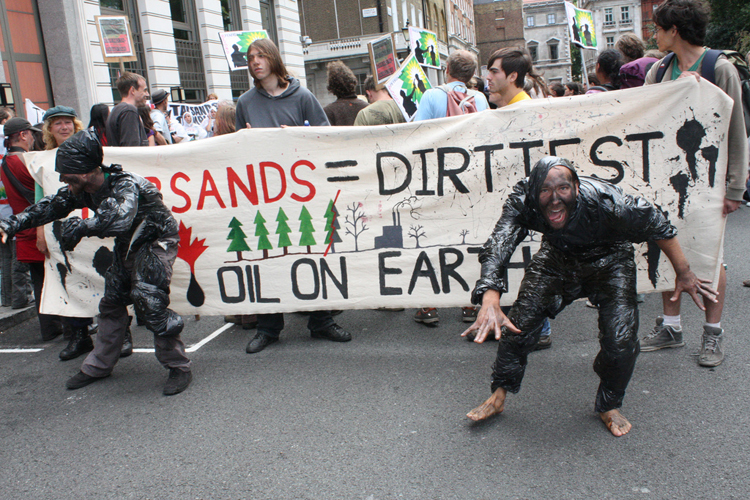 Disaster One. New estimates put the amount of oil per day pouring into the Gulf of Mexico at one million gallons a day.
Disaster One. New estimates put the amount of oil per day pouring into the Gulf of Mexico at one million gallons a day.
If this is so, BP’s disaster may have spilt more oil than the Exxon Valdez, when at least eleven million gallons poured from the stricken tanker.
Disaster Two. There is another ecological disaster on the US Gulf Coast. And this one is unseen and unnoticed. Until now. And once again BP is a guilty party.
You may have thought that the dirty tar sands was only a North American problem. But it is not.
In the US Gulf Coast, the dirty Canadian tar sands are refined into petroleum products and then shipped to the thirsty markets of Europe.
So the bad news for European consumers is that you may have thought you were not putting tar sands in your tank. But you could well be.
According to a new report by Greenpeace – Tar Sands in Your Tank Exposing Europe’s Role in Canada’s Dirty Oil Trade – “tar sands crude oil have been regularly entering the EU’s petroleum supply chain for some time, primarily through imports of diesel from the US Gulf Coast (USGC).”
For anyone not versed in the peculiarities of the petroleum market, it might seem strange that Europe – that refines vast amounts of petroleum products itself – is importing refining products from the US. But that is because there are more diesel cars in Europe.
So there is greater demand for diesel refined products in Europe than in the US.
The environmental pressure group argues that “A significant rise in the trade in diesel fuel between the USGC and the EU since 2008 is likely to continue to provide crucial support for the struggling refinery industry in the region. The trade is supported by a structural diesel deficit in the EU market and a similar surplus in the US.”
Greenpeace has found that that there are at least three refineries which both source from the Alberta tar sands and export products to Europe. These are:
- Valero Energy’s Port Arthur refinery, which since at least June 2009 has regularly processed tar sands crude while exporting diesel to Europe;
- BP’s Texas City refinery is a regular exporter of diesel and other products to Europe. During the course of Greenpeace’s investigation, BP purchased only one consignment of tar sands crude.
- ExxonMobil’s refinery in Baytown near Houston, Texas is currently the largest in the US and is integrated with one of the biggest petrochemical complexes in the world. This refinery purchases about 11% of the tar sands crude entering the Gulf Coast and made at least one shipment of diesel to Europe.
So, whilst Greenpeace acknowledges that the level of contamination with tar sands crude in the diesel reaching Europe from the Gulf Coast refineries is currently low, it says it is set to grow significantly.
It all comes down to pipeline capacity. Currently the supply of tar sands from Canada to the Gulf Coast is constrained by sufficient pipeline capacity.
But the industry wants expansion through the “Keystone XL” pipeline, which extends and adds additional capacity to the existing pipeline network.
The proposed pipeline could deliver up to 500,000 barrels per day (b/d) of tar sands crude directly from Alberta to Texas by 2013. This is compared to just 100,000 b/d now.
The proposal has considerable industry support. Regulatory approval has already been granted in Canada, and the process is underway in the US.
So the problem for European motorists is that when the fill their car up, they could be expanding the tar sands. This places both European consumers and more importantly the regulators in a unique position to stem the growth in tar sands production.
The EU does have legislation in development that should restrict imports of high carbon intensity petroleum products such as the tar sands, in the form of the Fuel Quality Directive, but Greenpeace argues “this needs significant strengthening – and rigorous implementation – to do the job. “
The group argues that “If European regulators fail to get this right, European consumers will be increasingly putting tar sands fuel in their tanks and playing a major role in driving the destructive growth of tar sands production.”
So European drivers – next time you fill up – ask where your fuel comes from..

I agree basically with what you are saying, however I do not wish to pay more than 3 per gallon for gas.
I think that we should stop speculation in oil on Wall street, and yes look for as many alternatives as possible.
However, gas, derived from oil, is the only economical way to fuel our automobiles at present, so I think that we will be stuck with oil for a while.